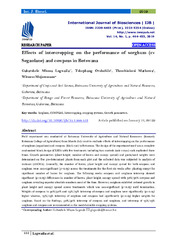| dc.contributor.author | Legwaila, Gabatshele Mbona | |
| dc.contributor.author | Otshubile, Tshephang | |
| dc.contributor.author | Mathowa, Thembinkosi | |
| dc.contributor.author | Mojeremane, Witness | |
| dc.date.accessioned | 2020-03-04T09:51:01Z | |
| dc.date.accessioned | 2021-03-15T09:19:19Z | |
| dc.date.available | 2020-03-04T09:51:01Z | |
| dc.date.available | 2021-03-15T09:19:19Z | |
| dc.date.issued | 2019 | |
| dc.identifier.citation | Legwaila, G. M., Otshubile, T., Mathowa, T., & Mojeremane, W. (2019). Effects of intercropping on the performance of sorghum (cv Segaolane) and cowpeas in Botswana. International Journal of Biosciences, 14(1), 444-453. | en_US |
| dc.identifier.issn | 2222-5234 | |
| dc.identifier.uri | https://pdfs.semanticscholar.org/7085/0071aeefba72b1c5580236d1adfbd00b085c.pdf | |
| dc.identifier.uri | http://moodle.buan.ac.bw:80/handle/123456789/237 | |
| dc.description.abstract | Field experiment was conducted at Botswana University of Agriculture and Natural Resources (formerly Botswana College of Agriculture) from March-July 2016 to evaluate effects of intercropping on the performance of sorghum (segaolane) and cowpeas (black eye) in Botswana. The design of the experiment used was a complete randomized block design (CRBD) with five treatments including two controls (sole crops) each replicated three times. Growth parameters (plant height, number of leaves and canopy spread) and grain/seed weights were determined on five pre-determined plants from each plot and the collected data was subjected to analysis of variance (ANOVA). Generally, the number of leaves, plant height and canopy spread for both cowpeas and sorghum were non-significant (p˃0.05) across the treatments for the first six weeks after planting except for significant number of leaves for sorghum. The following weeks cowpeas and sorghum intercrop showed significant (p˃0.05) across the treatments for the first six weeks after planting except for significant number of leaves for sorghum. The following weeks cowpeas and sorghum intercrop showed significant (p<0.05) differences in number of leaves, plant height, canopy spread with 50%/50% cowpeas and sorghum revealing superior absolute numbers most of the time. However, sorghum exhibited reduced growth in plant height and canopy spread across treatments which was non-significant (p˃0.05) until termination. Weights of cowpeas in 50%/50% and 25%/75% intercrop of cowpea and sorghum were significantly (p<0.05) higher whereas, 75%/25% intercrop of sorghum and cowpeas had significantly (p<0.05) higher weights for sorghum. Based on the findings, 50%/50% intercrop of cowpeas and sorghum, and intercrop of 75%/25% sorghum and cowpeas are recommended as the most desirable cropping systems. | en_US |
| dc.language.iso | en | en_US |
| dc.publisher | International Network for Natural Sciences | en_US |
| dc.relation.ispartofseries | International Journal of Biosciences (IJB);Vol. 13 (2) 2017 | |
| dc.subject | Sorghum | en_US |
| dc.subject | COWPEAS | en_US |
| dc.subject | Intercropping | en_US |
| dc.subject | Cropping systems | en_US |
| dc.subject | Growth parameters | en_US |
| dc.title | Effects of intercropping on the performance of sorghum (cv Segaolane) and cowpeas in Botswana | en_US |
| dc.type | Article | en_US |

